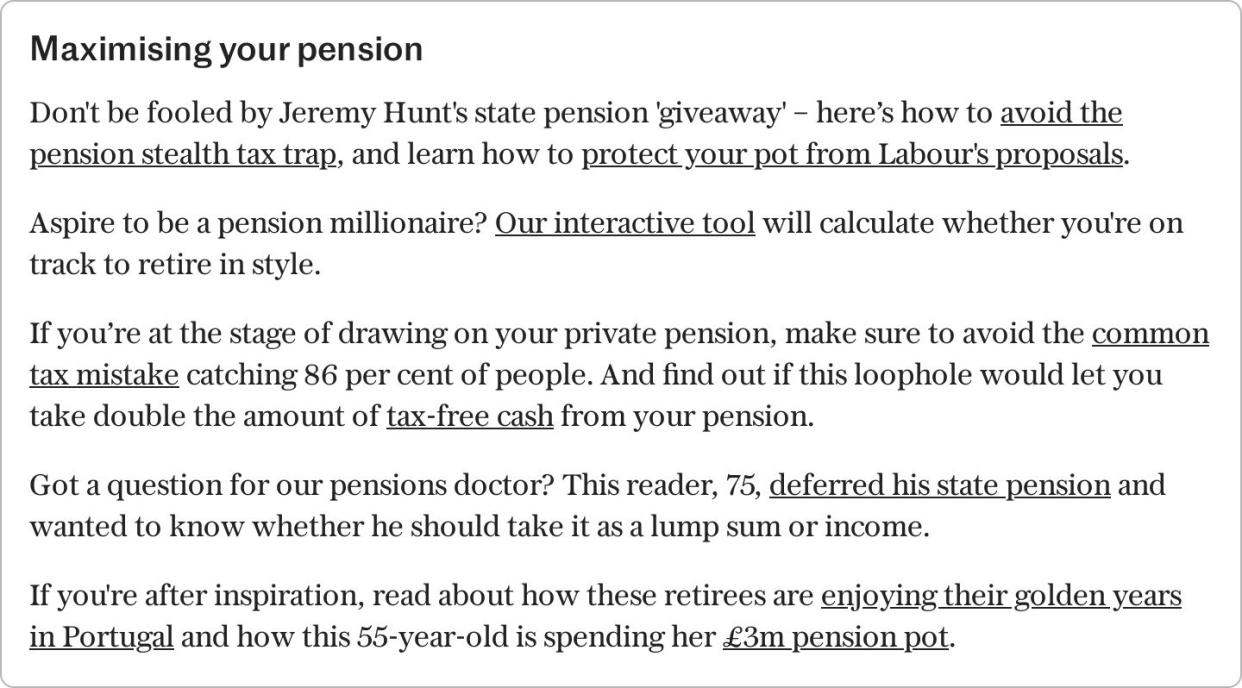‘I’m 50, with £750,000 saved – can I afford to retire early?

Would you like Victoria to rate your portfolio? Email money@telegraph.co.uk with the subject line: “Rate my portfolio”. Please include a breakdown of your portfolio, your age and what your investing goals are. Full names will not be published.
Hi there,
I am a 50-year-old man earning £125,800 a year with about £740,000 in pension savings, £6,300 in a stocks and shares Isa, and about £18,000 in cash Isas.
I am currently building up my cash Isa again after some house refurbishment last year, and when it is about £30,000, I am planning to divert £2,000-£3,000 a month to my stocks and shares Isa.
I have a lot of funds across all three main investments, but I like managing them. I try to be diversified, and am willing to take a bit more risk with the stocks and shares Isa by investing thematically.
Overall I wonder if this approach is all too complicated? Am I too thinly spread, or is this a good hedge against risks?
I worry that my bond exposure is too narrow with one fund across all three investments, but I find bonds confusing and worry about them more than equities (ironically).
Might I be in a position to semi-retire in seven years or so?
Mike



Victoria says:
Dear Mike,
It is good to see you’ve got strong annual earnings, a very healthy pension pot and an impressive focus on your investments and financial future.
Plus, you’re clearly asking all the right questions about things like your investment approach, your equity-bond mix, your level of diversification, and whether you’re on track to retire soon. I’ll certainly do my best to answer these by the end of this piece.
Kicking off with your more adventurous stocks and shares Isa. Taken in isolation, it looks well diversified with a nice spread across 15 different holdings, none of which are taking up too big a percentage of this pot.
However, when we look at this account in the context of your overall holdings, your fund holdings are very small compared to your overall invested assets, since your £6,000 Isa is dwarfed by your £740,000 pensions.
Take your allocation to Fundsmith Equity for example, which is about 10pc of your Isa. This £634 investment is less than 0.1pc of your Isas and pensions combined, which is way too tiny to move the dial for you.
So, to answer your initial questions, I’d say yes, I think you might be spreading yourself too thinly, and yes, you might be overcomplicating things by focusing on thematic investing here.
Recommended
How to build the perfect investment portfolio
While I like your active approach, which contrasts with your passive allocations in one of your pensions, I’m also worried that it is a bit of a scatter-gun portfolio, in which you seem to have picked funds you like the sound of without too much strategic thinking about how they fit in with the bigger picture, i.e. your overall portfolio.
You might want to think about reducing your overall number of holdings in your stocks and shares Isa, focusing on a couple of core funds instead. Having about two-thirds of your overall portfolio in well-diversified shares that offer access to core markets or global shares is the first thing to get right.
Given you want your Isa to be more active, I like investment trusts for this part of the portfolio, such as F&C or Alliance Trust, which both own about 400 and 200 shares respectively from around the world. Both have been ahead of the AJ Bell funds you own over the past five years. And trusts with built-in diversification like these will help to hedge your portfolio against risks while saving you the hassle of having a large number of holdings. But do your own research to decide which funds or trusts appeal most to you and your risk appetite – if you need inspiration, Interactive Investor’s Super 60 rated list is a good place to start for investment ideas.

On the satellite allocation, I like how you have tried to select winning technology themes, such as semiconductors and robotics. To simplify this technology allocation, you could trust a fund manager that invests across the entire sector to pick winners for you. Ben Rogoff, manager of the Polar Capital Technology Trust, is a leading investor in the space – and at an 8pc discount the trust offers good value.
Looking at your pensions, having £315,000 in passive funds and £430,000 in active funds is a good split. In the active pension, you’re making sure not to be over-invested in the US, which I think is very sensible given the high valuations there and the recent strong run of the Magnificent Seven shares. Having a mixture of growth and value funds makes sense.
One big red flag in your portfolio is the major shortage of bonds. The “100 minus your age” rule gives you a good jumping off point for what percentage of your portfolio should be allocated to equities. So at age 50, you might like to consider a 50-50 split between equities and bonds. However, since you’re not overly comfortable with bonds and you’re not averse to taking on risk, perhaps 60-40 might be better for you. With less than 10pc of your portfolio invested in bonds, I think it makes sense to up your allocation to fixed income.
UK government bonds – or gilts – have been attracting a lot of cash on the Interactive Investor platform, with one gilt – TN25 – attracting more cash than any other investments for the last 10 months owing to the high yields and tax breaks on offer.
Thanks to interest rate rises, bonds offer good yields now, at just over 4pc for gilts and 5.5pc for the safest corporate bonds.
They should hopefully also rise in value when central banks begin to cut interest rates so offer good chances of capital gains, too. To beef up your allocation, take a look at Royal London Corporate Bond, Vanguard Global Bond Index Hedged and M&G Global Macro Bond. The risk to bonds is that inflation rebounds and rates have to rise again, but the good thing is that, unlike three years ago before the inflationary spike, bonds offer high incomes to compensate you for any capital losses.
In terms of whether you will be able to semi-retire in seven years, it is tricky to provide a definitive answer unfortunately as none of us know how long we’re going to live nor how the markets are going to perform.
A few things to think about, though – remember that your state pension age is currently 67, so you’ll need to decide how long you’d feel comfortable either quitting or winding down work before that income kicks in.
Also think about what standard of living you’re hoping for during retirement – the Pension and Lifetime Savings Association (PLSA) estimates that a single person needs £14,400 a year for a minimum income, or £43,100 a year for a comfortable retirement. Don’t forget about inflation, too, because your pension pot today could be worth a lot less in 20 or 30 years’ time.
Finally, if you do wish to retire sooner rather than later, start looking into dividend and income funds to invest in during your pension years so you can try to live off that income (at least partly), rather than purely eating away at your savings and investments.
Victoria is head of investment at Interactive Investor. Her columns should not be taken as advice or as a personal recommendation, but as a starting point for readers to undertake their own further research.



